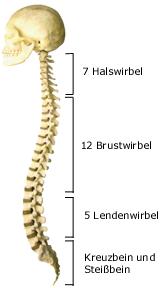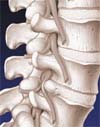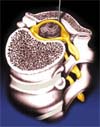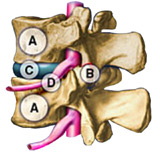
Praxisklinik für Orthopädie Dr. med. Kurt Schöppe - Prof. Dr. K.-P. Schulitz Orthopädie-Schmerztherapie-Chirugie Rochusstraße 289 - 53123 Bonn-Duisdorf Tel.: 0228 3863060 |
 |

|


Page Content |
Spine and vertebral disks
Diseases of the spine are widely spread. Almost three forth of the German population suffer of these disorders.That these sufferings do not become chronically, early treatment is extremely important. Because as longer as the pain exists, as more diffult it becomes to diagnose it and as more complex the treatment becomes.
The spine
The spine is the central element of the skeleton. It is not only the bony center of the body, it also joins all the other parts of the skeleton. Head, chest, hips, legs are directly or indirectly joined to the spine. It is also important for transmitting the impulses and stimuli due to the marrow in its center.
The spine can be divided into several parts starting from the top:
<typolist>cervical spine
thoracic spine
lumbar spine </typolist>
Each of these parts consists of several disks: we have alltogether 24 disks.
Each disk consists of a compact vertebral body looking like a pillar segment. The intervertebral discs are between these vertebral bodies (with the exception of the two disks closest to the head). The back side of the bodies with their closed arches form a channel from the head to the lumbar filled with marrow and the exiting nerves.
Looking at the vertebral column from the side it is obvious that the various parts of the spine are formed differently:
<typolist>The cervical spine is bent towards the inside (concave).
The thoracic spine is bowed towards the outside (convex).
The lumbar spine bends again towards the inside
and the pelvic spine towards the outside. </Typolist>
The human spine looks like a bent double S with its purpose to absorb and reduce the shocks due the erect habit of the human being.
The vertebral disks
The vertebral disks have a disk-like structure. All together they sum up to one quarter of the total length of the spine.
In particular, the vertebral disks consist of a jelly-like nucleus (lat.: Nucleus pulposus) and a fibrous cartilage (lat.:Anulus fibrosus). 90% of the nucleus pulposus consists of water. It has a shell, because it is surrounded by the annulus fibrosus consisting of several layers of fibrocartilage.
The metabolism of the vertebral disks is very slow. Essential minerals and liquids penetrate passively the tissue and are responsible for the necessary regeneration. Each vertebral disk looses a little bit of liquid during the day and becomes a little bit smaller in this in the evening in this way. Therefore, the body size can be up to 3 cm smaller in the evening. During the night, the tissue is refilled with liquid.
The spine is flexible due to its vertebral segments. A vertebral segment consists among others of the disks, ligaments and joins. The movement within a segment is very small, however it adds up to the overall huge flexibility of the spine, which adjust to each movement. The nucleus palposus works like a compressed water cushion. In the neutral position, it is centered for a healthy vertebral disk. While moving, it is pushed towards the outside guided by the annulus fibrosus. Size and vertical movement are buffered by the vertebral disk. The intervertebral disks are perfectly equilibrated bumpers.
The ability of the vertebral disk to swell is reduced by the age, the instability of the nucleus palposus and its buffering ability become smaller and smaller. The consequences are reduced spaces between the disks. Remarkable is also that the smaller disks are more used and consequently are abraded much faster. Due to the reduced ability of the verterbral disk to get back to the neutral position it can bulge out towards the backside and push on a nerve ending. These change are called a vertebral disk protusion and are nothing else tha a bulging out.
If the annulus fibrosus rips and the nucleus pulposus leaks out, then we have a vertebral disk prolapse or a herniated disk. Another form of degeneration of the vertebral disk is the sequestration or secretion of the vertebral disk where parts of the inside are completely torn off and deposited somewhere else in the vertebral disk.
The damage of the vertebral disk is not only a desease of the elderly people. The first steps of the degeneration can occur already between the age of 20 and 30 years.
Modern surgery of the vertebral disk - do we always need to operate?
The approaches to surgeries at the vertebral disks completely changes in last couple of years. Nowadays small punctures through the skin of a few millimeters are mostly sufficient.
However, before deciding which methode will be the right one, a pain has to be checked thouroughly. All conservative treatments can be used only after an exact didagnosis, provided that no neurological loss or chronic pain exists.
Only after trying all minimal invasive methode of the pain therapy without success, and, in addition, if the pain led already to paralysed arms and/or legs, only then a surgery has to be performed.
© TaKo



